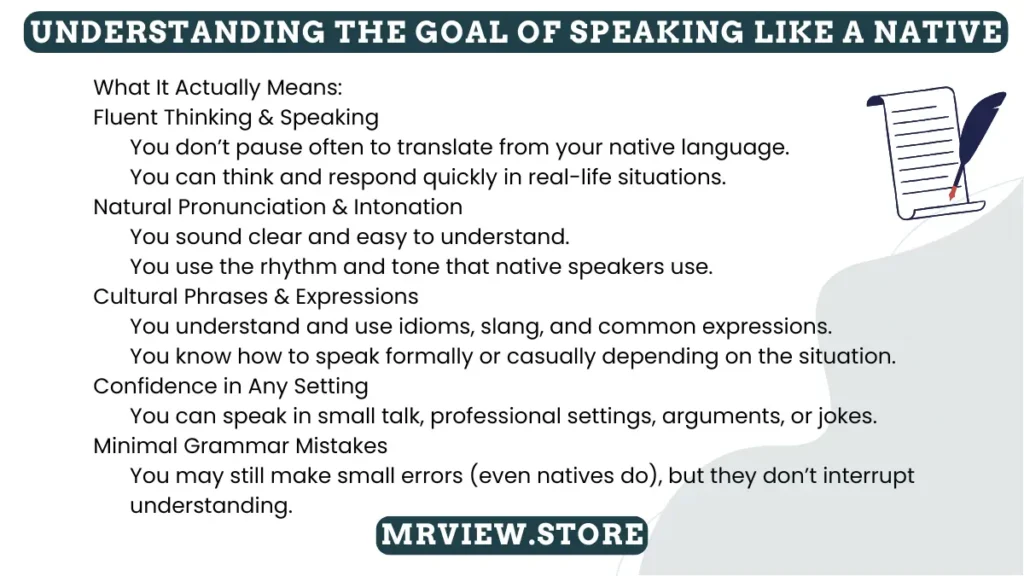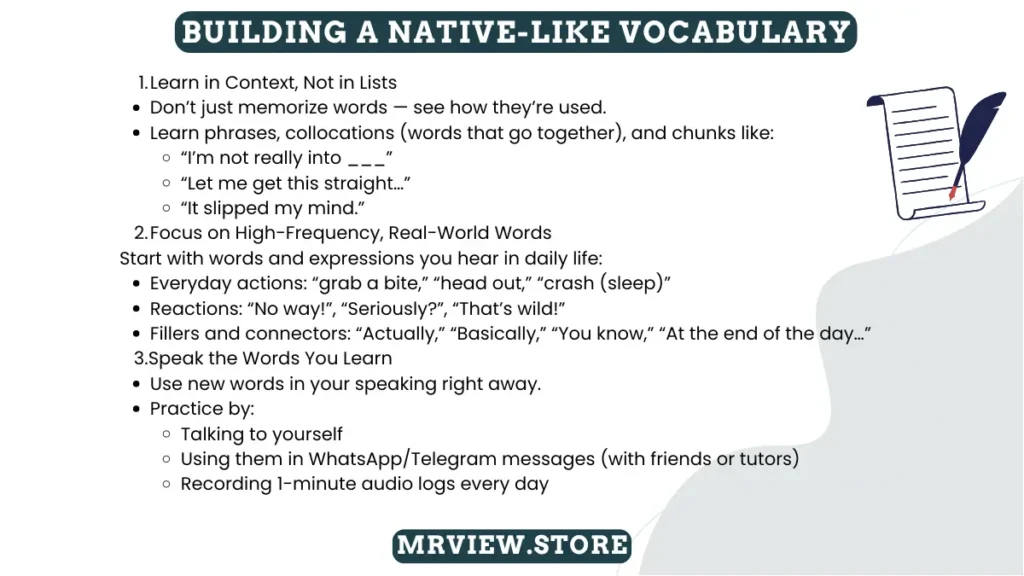Introduction
Wanna sound like you were born speaking English? You’re not alone! Millions of learners dream of reaching that smooth, natural level of fluency — the kind that makes people say, “Wait, you’re not a native speaker?” But here’s the thing: mastering native-level English isn’t about perfection — it’s about connection, rhythm, and confidence.
In this guide, we’ll unpack everything you need — from pronunciation hacks to daily speaking habits, and even the secrets behind those quirky idioms native speakers love. Whether you’re a student, a professional, or just someone chasing fluency for fun, this step-by-step plan will help you speak English more naturally, confidently, and effortlessly.
Understanding the Goal of Speaking Like a Native
1.1 What Does It Mean to “Sound Like a Native”?
Let’s get one thing straight — sounding like a native doesn’t mean you need to ditch your identity or copy someone else’s voice. It’s about communicating clearly, using natural expressions, and matching the tone and rhythm of fluent speakers. Native-like speech is full of contractions, casual phrasing, and stress patterns that bring words to life.
Think about how people say “I’m gonna go” instead of “I am going to go.” Or “Wanna hang out?” instead of “Do you want to hang out?” These tiny shifts make a huge difference.
1.2 The Real Benefits of Native-Like Fluency
So, why aim to speak like a native? First, it boosts understanding — both for you and the people you’re talking to. You’ll blend in better during conversations, meetings, or interviews. Second, it builds trust. When your English feels effortless, others feel more relaxed talking with you.
But here’s the kicker: you also gain confidence. Suddenly, you’re not just speaking — you’re connecting. Whether it’s ordering coffee, sharing ideas, or cracking jokes, it all becomes more natural.
1.3 It’s Not About Perfection — It’s About Practice
Let’s bust a myth: you don’t have to be perfect. Even native speakers make mistakes. The key is to practice regularly, stay curious, and not be afraid to sound silly sometimes. In fact, every mistake is a step closer to fluency.
Want a shortcut? Try listening to native speakers every day. YouTube channels like Rachel’s English break down native pronunciation in fun, bite-sized lessons.
Coming up next, we’ll show you exactly how to immerse yourself in English, no matter where you live.

Immersing Yourself in the English Language
2.1 Surround Yourself with English Daily
Want to speak English like a native? Then you’ve gotta live and breathe it. Immersion is key. Even if you don’t live in an English-speaking country, you can still create your own language bubble.
Start with simple swaps:
- Change your phone and social media to English.
- Watch Netflix shows, YouTube videos, and listen to podcasts in English.
- Read books, blogs, or even memes — yep, memes count.
Try to think in English, too. It sounds weird at first, but it trains your brain to process the language faster. When you wake up, describe what you’re doing in English: “I’m brushing my teeth. I need breakfast. Where’s my phone?”
2.2 Listen Actively, Not Just Passively
Listening is one thing. Active listening? That’s the secret sauce. Don’t just let the words fly past you — focus on pronunciation, intonation, and how words are connected. Notice how native speakers:
- Use contractions (can’t, won’t, shouldn’t).
- Drop certain sounds (like “gonna” for “going to”).
- Stress and pause in natural ways.
A great place to start? Try BBC Learning English — they’ve got tons of free listening practice with real-life accents.
Also, repeat what you hear — it’s called shadowing. Play a short clip, pause, and mimic the speaker’s tone, rhythm, and emotion. You’re not just repeating words — you’re training your musical ear for English.
2.3 Engage in Real Conversations
You can’t just study English. You’ve gotta use it. Speaking is a skill you build like muscle — with practice, not just theory.
Join language exchange apps like Tandem or HelloTalk. Or jump into online English-speaking groups. Don’t worry about being perfect — most native speakers are happy to help if you’re polite and interested.
Wanna take it further? Try recording yourself and playing it back. Yeah, it might feel cringey at first. But hearing yourself helps you notice and fix pronunciation errors you didn’t catch while speaking.
Mastering Pronunciation and Natural Speech Patterns
3.1 Focus on Pronunciation, Not Just Words
So, you’ve got the vocabulary and grammar down — great! But if you want to sound like a native, pronunciation is non-negotiable.
Here’s the trick: English spelling and pronunciation don’t always match. (Thanks, silent letters.) That’s why learning how to pronounce words correctly matters more than just knowing how they’re spelled.
Use online tools like Forvo to hear native speakers say words naturally. It’s super helpful, especially for tricky ones like “colonel,” “schedule,” or “entrepreneur.”
3.2 Learn the Sounds and Phonemes of English
English has 44 phonemes — the individual sounds that make up spoken words. Some may not exist in your native language, which can make pronunciation tough.
- Practice minimal pairs like “ship” vs. “sheep” or “bat” vs. “bet.”
- Pay attention to voiced vs. voiceless sounds (e.g., “zoo” vs. “sue”).
- Learn how to shape your mouth and tongue for tough sounds like “th.”
Apps like ELSA Speak use AI to give real-time pronunciation feedback, which is way better than guessing in the mirror.
3.3 Understand English Intonation and Stress
Here’s where things get interesting: intonation, word stress, and sentence rhythm can totally change meaning.
Native speakers don’t speak word by word — they use stress to show emotion, importance, or attitude. For example:
- “I didn’t say she stole the money” has 7 different meanings depending on which word you stress.
Also, English is a stress-timed language, meaning some syllables are longer and louder than others. This gives English its signature rhythm — kind of like music.
To get better:
- Mimic movie lines with emotion.
- Sing along with English songs.
- Try shadowing TED Talks or interviews with natural flow.
3.4 Practice Connected Speech
Here’s a native speaker superpower: connected speech. It’s when words blend together in real conversation. Think:
- “Gimme a sec” instead of “Give me a second.”
- “Whaddya wanna do?” instead of “What do you want to do?”
This happens all the time and makes non-native speakers go, “Wait, what?!”
To catch up:
- Practice common reductions and linking.
- Record and compare your speech to native examples.
- Use slow playback tools on YouTube to study how sentences melt together.
Building a Native-Like Vocabulary
4.1 Ditch Textbook Language for Real Expressions
If you’re still saying “I am fine, thank you” every time someone asks how you are, we need to upgrade your phrases!
Native speakers use colloquialisms, slang, and idioms all the time. They rarely speak like a textbook.
Instead of:
- “I am very tired,” say “I’m beat.”
- “It’s raining a lot,” say “It’s pouring.”
- “I don’t know,” say “Beats me” or “No clue.”
Immersing yourself in real-life English — think TV shows, podcasts, and casual conversations — helps you pick these up naturally.
Try watching shows like Friends or The Office, or listen to casual English podcasts such as The English We Speak by BBC for fun idioms and slang.
4.2 Use Phrasal Verbs and Everyday Contractions
Phrasal verbs are the bread and butter of native English. Instead of “depart,” we say “head out.” Rather than “continue,” it’s “keep going.”
Here are some everyday ones:
- Run into – to meet unexpectedly
- Put off – to postpone
- Figure out – to understand or solve
You’ll sound way more natural using:
- “Let’s hang out” rather than “Let us meet casually.”
- “I can’t make it” instead of “I will not be able to attend.”
Oh, and contractions? Use them. Always. Native speakers contract nearly everything:
- I’m, you’re, he’s, she’ll, they’d, we’ve, etc.
4.3 Use Vocabulary in Context, Not Isolation
It’s tempting to memorize long word lists, but you’ll retain vocabulary better by learning it in context. That means:
- Read short stories or news articles.
- Watch YouTube videos with subtitles.
- Note down phrases, not just words.
Use tools like Anki or Quizlet to create spaced repetition flashcards with full sentences, not isolated words. It trains your brain to remember how words are used, not just their meaning.
4.4 Learn Collocations and Word Combinations
Native speakers instinctively know which words “go together.” These combos are called collocations.
You’ll hear:
- “Make a decision” not “do a decision.”
- “Heavy rain” not “strong rain.”
- “Take a break” not “have a break” (in most cases).
Learning these will make your English sound polished — almost automatic.

Master English Through Immersion
5.1 What Is Language Immersion?
Imagine learning English the same way you learned your first language — by being surrounded by it. That’s what immersion is all about. It means living and breathing the language as much as possible.
The good news? You don’t have to move to London or New York to immerse yourself. You can turn your environment into an English bubble right where you are.
5.2 Create an English-Only Zone Around You
Start by switching your digital life to English. Change your phone’s language settings, follow English-speaking influencers, and subscribe to native English YouTube channels or stream series in English.
Every time you scroll or binge-watch, you’re absorbing vocabulary, sentence structures, and tone — all subconsciously.
Here’s what to do:
- Turn on English subtitles while watching shows.
- Label things in your room with sticky notes in English.
- Talk to yourself in English throughout the day. (Yep, sounds silly, but it works!)
And don’t forget to practice shadowing — listen and repeat native speakers line by line. Try this with TED Talks, audiobooks, or episodes from BBC Learning English – 6 Minute English for a great daily habit.
5.3 Surround Yourself with Native English Speakers (Virtually!)
If you can’t travel, bring native speakers to you. There are countless apps and platforms to connect with them:
- Tandem and HelloTalk for language exchanges.
- italki and Preply for structured lessons with native tutors.
Engaging in real-time conversations helps you:
- Get instant feedback
- Hear natural accents and rhythms
- Build confidence in everyday English
Plus, native speakers often correct gently and help you sound more natural — so don’t be shy!
5.4 Think in English
Thinking in your native language and translating into English slows you down. To sound fluent, you need to think directly in English.
Here’s how to build this habit:
- Narrate your daily actions: “I’m brushing my teeth. Now I’ll make breakfast.”
- Make mini-speeches in your head when walking or waiting.
- Ask yourself questions in English and answer them aloud.
Over time, your brain starts working in English naturally — and boom, you’re speaking without hesitation!
Nail Pronunciation and Intonation Like a Native
6.1 Why Pronunciation Matters More Than You Think
You could know every grammar rule, memorize thousands of words, and still sound robotic or unclear if your pronunciation is off. Speaking like a native is way more than vocabulary — it’s about how you say things.
Native speakers focus heavily on:
- Stress (which syllable gets the “boom”)
- Rhythm (the musical flow of speech)
- Intonation (the rise and fall of your voice)
And guess what? Mastering these will make you sound instantly more fluent — even if you speak slowly.
6.2 Break Down the Sounds: Phonemes and Linking
English has some sneaky sounds that don’t exist in many other languages, like:
- The “th” in this or think
- The difference between ship and sheep
- The linking sounds where words blend together: “want to” → “wanna”
To sound natural, you need to train your ears and mouth. One of the best ways is by using the Sounds of Speech website, where you can see mouth positions for every English sound.
Try this:
- Pick 2–3 difficult sounds.
- Practice them daily using minimal pairs (e.g., “bit” vs “beat”).
- Record yourself and compare with native speakers.
6.3 Master the Melody: Intonation and Stress
English isn’t spoken in a flat tone — it’s full of ups and downs. Intonation can completely change the meaning of a sentence.
Compare:
- “You’re coming.” (neutral)
- “You’re coming?” (a surprised question)
- “You’re coming!” (excited tone)
Stress is just as important:
- I didn’t say she stole the money. (Each word, when stressed, changes the meaning.)
To practice, mimic real-life conversations from movies, podcasts, or interviews. One solid tip? Use tools like YouGlish to hear how native speakers say any word or sentence in different contexts.
6.4 Shadowing: The Fast Track to Native Sounding Speech
Shadowing is a proven technique where you:
- Listen to a short native sentence.
- Repeat it immediately, copying the tone, speed, and emotion.
- Repeat until you sound identical.
Use short clips from TED Talks, news reports, or even sitcoms. Apps like Elsa Speak can also give feedback on how native you sound.
Do 10–15 minutes of shadowing daily and watch your accent level up fast.

Build Confidence and Stay Consistent
7.1 Speak Up, Even If You Make Mistakes
Let’s be real — fear is the biggest block. Most English learners know more than they show, simply because they’re afraid of making mistakes.
But here’s the truth: even native speakers mess up. So, embrace your errors. Each slip-up is a stepping stone to mastery. The key is to practice speaking daily, even if it’s just talking to yourself in the mirror!
Pro tip: Use platforms like Speaky to connect with native speakers for casual conversations. No judgment. Just real practice.
7.2 Develop a Daily Speaking Routine
You don’t need to spend hours — just be consistent. Try this simple plan:
- Morning: Read a short English news article out loud.
- Afternoon: Record yourself explaining your day.
- Evening: Watch a 5-min video and shadow the speaker.
Even 20 minutes daily can skyrocket your fluency in weeks!
7.3 Track Progress and Celebrate Small Wins
Fluency takes time, but it’s so easy to get discouraged when you don’t see instant results. That’s why it’s crucial to:
- Keep a speaking journal (record audio entries).
- Re-listen monthly to hear your improvement.
- Celebrate small wins — like understanding a fast podcast or ordering food in English with confidence.
Progress is progress, even if it’s slow.
7.4 Use English in Real Life
Don’t keep English locked in your textbook. Take it out into the real world:
- Join English-speaking forums or subreddits.
- Write reviews on products in English.
- Comment on YouTube videos or blog posts in English.
By living in the language, you build confidence naturally — no pressure, just fun!
7.5 Mindset Matters Most
Lastly, remind yourself: you are capable. Don’t compare your journey to anyone else’s. Some may sound fluent in months, others in years — both are okay.
FAQs
1. Can I really sound like a native English speaker?
Yes! While it may take time and effort, mimicking native pronunciation, learning natural expressions, and immersing yourself in spoken English can help you sound very close to a native speaker. Consistency and exposure are key.
2. How long does it take to speak English fluently?
Fluency depends on your starting level, study habits, and daily practice. With focused effort and regular speaking practice, many learners reach conversational fluency in 6–12 months, and near-native fluency in 1–2 years.
3. What’s the fastest way to improve my English accent?
The fastest way is to use shadowing, where you repeat after native speakers in real time. Combine this with listening to podcasts, watching movies, and using apps like ELSA Speak to refine your pronunciation and intonation.
4. Should I focus more on grammar or speaking?
If your goal is to sound like a native, speaking should take priority. Grammar is important, but natives often use informal or contracted grammar when speaking. Learn to communicate clearly and naturally first — grammar can follow.
5. How do I stop translating in my head when speaking English?
Practice thinking directly in English by narrating your actions, writing short notes, or keeping a diary in English. The more you immerse yourself in the language, the quicker your brain will switch to “English mode.”
6. Is it okay to mix accents when speaking English?
Yes, it’s natural for learners to mix accents, especially early on. The goal isn’t perfection — it’s clarity and confidence. Over time, you can adjust your accent by choosing one to focus on (like American or British English).
Conclusion: Your Journey to Native-Level English Starts Now
Speaking English like a native isn’t some unreachable dream — it’s a doable goal with the right mindset and methods. Whether you’re fine-tuning your pronunciation, soaking up idiomatic expressions, or building real conversational confidence, every small step gets you closer.
Don’t get hung up on sounding “perfect.” Even native speakers make slips! What really matters is sounding natural, confident, and comfortable — and that comes from daily practice, active listening, and speaking as much as possible.
So, what’s next? Pick a few techniques from this guide, stick to them, and dive headfirst into your English-speaking journey. You’ve got this — and the native-level fluency you’ve been dreaming of? It’s already within reach.
